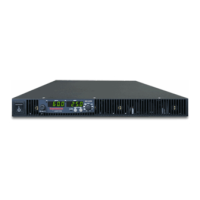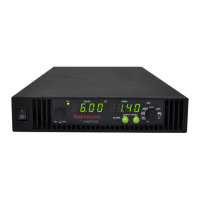
Do you have a question about the Ametek Sorensen XG 6-110 and is the answer not in the manual?
| Output Voltage Range | 0-6 V |
|---|---|
| Output Current Range | 0-110 A |
| Power Rating | 660 W |
| Output Type | DC |
| Frequency | 47-63 Hz |
| Operating Temperature | 0 to 50 °C |
| Cooling | Forced air |
| Efficiency | 85% |
Describes the stable, variable output voltage and current capabilities of the XG Family Power Supply.
Lists the models in the XG 850 Watt series covered by this manual.
Describes the physical front panel interface and its components for operation.
Details the components and functions of the XG power supply's front panel interface.
Illustrates and describes the rear panel connectors for the 850 Watt XG models.
Illustrates and describes the rear panel connectors for 1500 and 1700 Watt XG models.
Summarizes the essential steps for installing the power supply, referencing relevant sections.
Details the initial physical inspection and periodic cleaning requirements for the power supply.
Provides guidance on selecting a suitable location and mounting the power supply in a rack or benchtop.
Explains how to safely connect the power supply to the AC input power source.
Describes the AC input connector for the 1500 and 1700 Watt XG models.
Details the procedure for connecting the AC input wire for 1500 and 1700 Watt XG models.
Provides recommendations for selecting appropriate wire sizes based on current carrying capacity.
Illustrates the maximum allowable wire length for sense lines based on load current and voltage drop.
Outlines the procedures for performing basic power-on and functional checks of the power supply.
Describes how to verify the voltage and current modes of operation on the front panel controls.
Details how to connect loads to the power supply's DC output terminals, including safety precautions.
Provides cautions and guidance for driving inductive loads or batteries, including diode placement.
Explains recommended load connections for a single load, including local sensing.
Details how to connect remote sensing wires to shift the regulation point to the load.
Explains how to use the 9-position mode control and rotary Adjust/Enter for front panel configuration.
Describes the coarse and fine adjustment modes used for setting voltage, current, OVP, and UVP.
Explains the general procedure for navigating the XG's menu system for setting features.
Describes the normal display behavior and the inactivity timeout feature for front panel operations.
Lists and describes the text messages displayed on the front panel to indicate status or mode.
Explains local control via front panel and how it interacts with remote interfaces.
Describes the three operating modes: Constant Voltage, Constant Current, and Constant Power.
Explains how the power supply operates in Constant Voltage mode.
Describes how the power supply automatically switches between CV, CC, and CP modes.
Details the procedure for enabling and disabling the main power output using front panel or SCPI.
Explains how to enable and disable the auxiliary output using the front panel or SCPI.
Configures the power supply's output state after a power cycle or restart.
Discusses various conditions that cause alarms and the handling of errors.
Provides procedures for clearing triggered, manual, and flash failure alarms.
Describes events that cause the ALARM LED to illuminate and its behavior after clearing.
Explains how to disable alarms using SCPI commands and the alarm mask.
Explains the OVP circuit's function to protect loads and how to set the trip point.
Details how to set the over voltage protection trip point via front panel or SCPI.
Explains the UVP circuit's function to prevent voltage settings below a set value.
Describes the OCP alarm as a firmware-based protection configurable via SCPI.
Explains the OTP lock function which protects the supply from overheating.
Details using the external shutdown function to enable or disable output via a logic level signal.
Explains how to set the polarity for the external shutdown signal to avoid false triggering.
Describes enabling or disabling loop protection for multi-unit daisy chain configurations.
Explains the interlock function for enabling or disabling output using an external shutoff switch.
Lists settings that are saved and recalled on a power cycle event.
Describes the three user setting memory locations for storing frequently used configurations.
Details the procedure for saving user setting memory locations using the front panel or SCPI.
Explains how to lock the front panel to prevent accidental button presses.
Details the soft reset procedure to return parameters to factory default values.
Explains how to operate power supplies in series for voltage or parallel for current.
Details connecting multiple power supplies in series to increase output voltage.
Explains parallel connection with remote sensing for improved load regulation.
Details setting up multiple supplies in parallel for current sharing using the APG method.
Explains how to control output voltage and current using analog input sources via APG.
Lists available analog monitor signals and related APG modes for feedback.
Describes the auxiliary outputs (+5V and +15V) and their programming options.
Details the pin functions and connections for the APG connector, including sense and programming.
Provides procedures for connecting output wires to the APG and DC output connector.
Offers recommendations for wire selection and grounding for APG connections, including safety.
Explains how to configure the analog programming mode for voltage and current control.
Details activating and deactivating APG voltage mode using an external voltage source.
Details activating and deactivating APG current mode using an external voltage source.
Details activating and deactivating APG voltage mode using an external resistor.
Details activating and deactivating APG current mode using an external resistor.
Describes how to read back voltage and current values using the APG connector.
Explains the ISOL mode for isolated analog programming of voltage and current.
Details the pin functions and connections for the ISOL connector, including auxiliary outputs.
Provides procedures for connecting external circuits to the Isolated Analog Programming Connector.
Details activating and deactivating ISOL voltage mode using an external voltage source.
Details activating and deactivating ISOL current mode using an external voltage source.
Overview of remote control capabilities using SCPI and various interfaces like RS-232, RS-485, USB, GPIB.
Information on setting up hardware and organizing connections for different remote interfaces.
Guides on configuring remote control via the RS-232 serial interface.
Details pinouts and specifications for the RS-232 communication cable connecting RJ-45 to DB-9.
Details pinouts and specifications for the RS-232 to DB-25 communication cable.
Guides on configuring the XG for RS-232 interface and setting up the PC terminal.
Guides on configuring remote control via the RS-485 serial interface.
Details cable setup for master-to-slave communication using RS-485.
Guides on connecting and configuring remote control using the USB interface.
Guides on downloading and installing the necessary drivers for USB to serial communication.
Explains how to verify the USB driver installation using Device Manager.
Describes the GPIB interface, its connector, and pin functions for optional GPIB connection.
Guides on selecting the communication port (RS-232, RS-485, USB, GPIB, LAN) for remote control.
Details connecting multiple power supplies to an RS-485 bus for networked control.
Explains the setup procedure for master and slave units in a multi-power supply configuration.
Details setting up terminal emulation software for serial communication with the power supply.
Details how to set the data rate for RS-232 and RS-485 communication protocols.
Explains how to set unique multichannel addresses for devices on RS-485 bus.
Explains how to address devices using multichannel addresses or selected device commands.
Explains the SCPI status reporting mechanism and the XG's implementation.
Presents the IEEE 488.2 model for status registers, detailing enable and summary bits.
Explains the Status Byte register, its bits, and summary messages.
Details the SESR, its enable command, and query for its contents.
Describes the 16-bit operation status register, including shutdown and protection summaries.
Shows the state of the current share configuration, controllable via front panel or SCPI.
Stores information on questionable events or status during operation impacting output quality.
Introduces remote control via LAN/Ethernet for XG Series with MEB option.
Provides information for network administrators on configuring LAN/Ethernet for the MEB option.
Details the features and requirements of the LAN (Ethernet) interface for programmable power supplies.
Presents three connection choices for remote control: LAN, direct to PC, and private network.
Guides setting up a private network connection, including static IP address assignment.
Explains the simplest network connection scenario where PC and supply are on the same side of the router.
Introduces the LXI Discovery Browser tool for locating compliant devices on a network.
Describes network configuration when the supply is behind a router, requiring port forwarding.
Introduces the EnetTest Utility for sending SCPI commands and receiving responses over Ethernet.
Provides step-by-step instructions for installing the EnetTest Utility software.
Explains how to use the utility by setting Host and Port fields for SCPI communication.
Details the methods for setting required LAN information: Ethernet, Serial/USB, or Web Interface.
Guides setting LAN parameters via Ethernet using the GetAssignIPAddress.exe utility.
Details how to set the IP address using SCPI commands or DHCP mode, including MAC and GW addresses.
Provides instructions for setting static IP addresses for Ethernet, USB, and Serial interfaces.
Guides setting a static IP address for the Ethernet interface using the LXI Discovery Browser.
Explains verifying the USB port number via Device Manager for communication.
Guides verifying communication port settings for RS232 and desired address.
Details system-level commands that control the power source functions.
Describes XG's compliance with LXI version 1.2, Class C, and its features.
Overview of calibration procedures performed via SCPI commands and items needing calibration.
Explains gain and offset errors in analog programming and the iterative calibration process.
Details the first step of calibration, adjusting gain to intersect ideal and real lines at 90%.
Details the second step of calibration, adjusting offset to intersect lines at 10%.
Details the third step of calibration, repeating gain adjustment for best results.
Explains how to save calibration data using CAL:STOR and restore using CAL:REST.
Provides procedures for gain and offset calibration of the output voltage.
Provides procedures for gain and offset calibration of the output current.
Details the procedure for calibrating the over voltage protection feature.
Guides calibration of the non-isolated voltage monitoring output lines.
Guides calibration of the non-isolated current monitoring output lines.
Details calibration of the non-isolated voltage programming of voltage.
Details calibration of the non-isolated resistive programming of voltage.
Details calibration of the non-isolated voltage programming of current.
Details calibration of the non-isolated resistive programming of current.
Outlines calibration procedures for isolated voltage monitoring, current monitoring, and programming.
Guides calibration of the isolated voltage monitoring output lines.
Guides calibration of the isolated current monitoring output lines.
Details calibration of isolated voltage programming of voltage.
Details calibration of isolated resistive programming of voltage.
Details calibration of isolated voltage programming of current.
Details calibration of isolated resistive programming of current.
Explains calibration of the VAP input signal for accurate measurements.
Provides SCPI command to restore the power supply to factory calibration settings.
Provides SCPI command to restore default calibration for all parameters.
Provides step-by-step instructions for immediate emergency shutdown procedures.
Outlines steps to take if the power supply displays unusual or erratic operation.
Provides guidance for operators to troubleshoot common issues and when to contact service.
Details the international standards and SCPI requirements the power supply conforms to.
Explains the tree structure of SCPI commands, organized by common roots or nodes.
Details SCPI command syntax, including long/short forms, punctuation, and abbreviations.
Explains how MIN and MAX can be used as alternative parameters for specific values.
Explains how to use a question mark (?) to query parameter values and best practices for multiple queries.
Illustrates the hierarchical structure of SCPI commands from root to leaf nodes.
Provides a summary of SCPI commands categorized by function.
Explains how errors are placed in a queue (FIFO) and how the queue is cleared.
Lists syntax errors detected by the instrument's parser and their descriptions.
Lists errors detected by the instrument's execution control block and common contributing conditions.
Lists errors detected by the instrument that are not command, query, or execution errors.
Lists errors related to output queue control and message exchange protocol problems.
Provides detailed electrical specifications for the XG 850 Watt models.
Lists the required AC input voltage and frequency specifications for the XG 850 Watt.
Provides detailed electrical specifications for the XG 1500 Watt models.
Lists the required AC input voltage and frequency specifications for the XG 1500 Watt.
Provides detailed electrical specifications for the XG 1700 Watt models.
Lists the required AC input voltage and frequency specifications for the XG 1700 Watt.
Lists output performance and isolation specifications applicable to all XG models.
Details the environmental operating and storage conditions for the power supply.
Provides physical dimensions, weight, and cooling information for XG models.
Describes available rack mounting options and provides part numbers for XG units.
Details rack mount kit options for installing XG units into half and full racks.
Specifies requirements for selecting a suitable installation location for the power supply.
Provides installation procedures for using 1U rails to mount the power supply.
Guides finding and installing Jonathan Engineered Solutions slides for rack mounting.
Notes that MEA option instructions are for reference only for 850 Watt models.
Guides on configuring the PC's network connection for Lantronix device setup.
Provides steps for installing the Lantronix DeviceInstaller software on the PC.
Instructs selecting the appropriate network adapter within DeviceInstaller for communication.
Details assigning an IP address to the power supply unit, especially for single computer configurations.
Guides configuring the XG to use the ENET option card as the active communication port.
Details setting up terminal emulation software like HyperTerminal for communication.
Provides troubleshooting steps for combined ENET/RS-485 communication and ENET setup.












